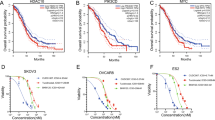Abstract
Molecular markers enabling the prediction of sensitivity/resistance to rapamycin may facilitate further clinical development of rapamycin and its derivatives as anticancer agents. In this study, several human ovarian cancer cell lines (IGROV1, OVCAR-3, A2780, SK-OV-3) were evaluated for susceptibility to rapamycin-mediated growth inhibition. The differential expression profiles of genes coding for proteins known to be involved in the mTOR signaling pathway, cell cycle control and apoptosis were studied before and after drug exposure by RT-PCR. In cells exposed to rapamycin, we observed a dose-dependent downregulation of CCND1 (cyclin D1) and CDK4 gene expression and late G1 cell cycle arrest. Among these cell lines, SK-OV-3 cells resistant to both rapamycin and RAD001 were the sole to show the expression of the anti-apoptotic gene Bcl-2. Bcl-2/bclxL-specific antisense oligonucleotides restored the sensitivity of SK-OV-3 cells to apoptosis induction by rapamycin and RAD001. These results indicate that baseline Bcl-2 expression and therapy-induced downexpression of CCND1 and CDK4 may be regarded as molecular markers enabling the prediction and follow-up of the cellular effects on cell cycle and apoptosis induction of rapamycin in ovarian cancer. Furthermore, strategies to down regulate Bcl-2 in ovarian cancer may prove useful in combination with rapamycin or RAD001 for ovarian cancer.
Similar content being viewed by others
References
Mills GB, Lu Y, Fang X, et al. The role of genetic abnormalities of PTEN and the phospatidylinositol 3-kinase pathway in breast and ovarian tumorigenesis, prognosis, and therapy. Seminars in Oncol 2001; 28(suppl 16): 125–141.
Hu L, Zaloudek C, Mills G, Gray J, Jaffe RB. In vivo and in vitro ovarian carcinoma growth inhibition by a phosphatidylinositol 3-kinase inhibitor (LY294002). Clin Cancer Res 2000; 6(3): 880–886.
Castedo M, Ferri KF, Kroemer G. Mammalian target of rapamycin (mTOR). Pro-and anti-apoptotic. Cell Death Differ 2002; 9: 99–100.
Shi Y, Frankel A, Radvanyi LG, Penn LZ, Miller RG, Mills GB. Rapamycin enhances apoptosis and increase sensitivity to cisplatin in vitro. Cancer Res 1995; 55(9): 1982–1988.
Hu L, Hofmann J, Lu Y, Mills GB, Jaffe RB. Inhibition of phosphatidylinositol 3'-kinase increases efficacy of paclitaxel in in vitro and in vivo ovarian cancer models. Cancer Res 2002; 62: 1087–1092.
Hidalgo M, Rowinsky EK. The rapamycin-sensitive signal transduction pathway as a target for cancer therapy. Oncogene 2000; 19(56): 6680–6686.
Majewski M, Korecka M, Kossev P, et al. The immunosuppressive macrolide RAD inhibits growth of human Epstein-barr virus-transformed B lymphocytes in vitro and in vivo: Potential approach to prevention and treatment of posttransplant lymphoproliferative disorders. Proc Natl Acad Sci USA 2000; 97(8): 4285–4290.
Neshat MS, Mellinghoff IK, Tran C, et al. Enhanced sensitivity of PTEN-deficient tumors to inhibition of FRAP/mTOR. Proc Natl Acad Sci USA 2001; 98(18): 10314–10319.
Podsypanina K, Lee RT, Politis C, et al. Aninhibitor of mTOR reduces neoplasia and normalizes p70/S6 kinase activity in Pten +/− mice. Proc Natl Acad Sci USA 2001; 98(18): 10320–10325.
Dudkin L, Dilling MB, Cheshire PJ, et al. Biochemical correlates of mTOR inhibition by the rapamycin ester CCI-779 and tumor growth inhibition. Clin Cancer Res 2001; 7(6): 1758–1764.
Huang S, Liu LN, Hosoi H, Dilling MB, Shikata T, Houghton PJ. p53/p21(CIP1) cooperate in enforcing rapamycin-induced G(1) arrest and determine the cellular response to rapamycin. Cancer Res 2001; 61(8): 3373–3381.
Hosoi H, Dilling MB, Liu LN, et al. Studies on the mechanism of resistance to rapamycin in human cancer cells. Mol Pharmacology 1998; 54: 815–824.
Castedo T, Roumier J, Blanco KF, et al. Sequential involvement of Cdk1, mTOR and p53 in apoptosis induced by the HIV-1 envelope. EMBO J 2002; 21: 4070–4080.
Decaudin D, Hirsch T, Geley M, et al. Bcl-2 and Bcl-XL antagonize the mitochondrial dysfunction preceding nuclear apoptosis induced by chemotherapeutic agents. Cancer Res 1997; 57: 62–67.
Chan T-F, Carvalho J, Riles L, Zheng XSF. Achemical genomics approach toward understanding the global functions of the target of rapamycin protein (TOR). Proc Natl Acad Sci USA 2000; 97(24): 13227–13232.
Hardwick JS, Kuruvilla FG, Tong JK, Shamji AF, Schreiber SL. Rapamycin-modulated transcription defines the subset of nutrient-sensitive signaling pathways directly controlled by the Tor proteins. Proc Natl Acad Sci USA 1999; 96(26): 14866–14870 (http://www.pnas.org/cgi/content/full/96/26/14866/DC1).
Zangemeister-Wittke U, Leech SH, Olie RA, et al. Anovel bispecific antisense oligonucleotide inhibiting both bcl-2 and bcl-xL expression efficiently induces apoptosis in tumor cells. Clin Cancer Res 2000; 6: 2547–2555.
Gautschi O, Tschopp S, Olie RA, et al. Activity of a novel bcl-2/ bcl-xL-bispecific antisense oligonucleotide against tumors of diverse histologic origins. J Natl Cancer Inst 2001; 93: 463–471.
Shinjyo T, Kuribara R, Inukai T, et al. Downregulation of bim, a proapoptotic relative of Bcl-2, is a pivotal step in cytokine-initiated survival signaling in murine hematopoietic progenitors. Mol Cell Biol 2001; 21(3): 854–864.
Shinoura N, Yoshida Y, Nishimura M, et al. Expression level of bcl-2 determines anti-or proapoptotic function. Cancer Res 1999; 59: 4119–4128.
Torgler R, Jakob S, Ontsouka E, et al. Regulation of activation-induced Fas (CD95/Apo-1) ligand expression in T cells by the Cyclin B1/cdk1 complex. J Biol Chem 2004; Epub ahead of print June 23.
Majumder PK, Febbo PG, Bikoff R, et al. mTOR inhibition reverses Akt-dependent prostate intraepithelial neoplasia through regulation of apoptotic and HIF-1-dependent pathways. Nat Medicine 2004; 10(6): 594–601.
Raymond E, Alexandre J, Faivre S, et al. Safety and Pharmacokinetics of Escalated Doses of Weekly Intravenous Infusion of CCI-779, a Novel mTOR Inhibitor, in Patients With Cancer. J Clin Oncol 2004; 22(12): 2336–2347.
Author information
Authors and Affiliations
Rights and permissions
About this article
Cite this article
Aguirre, D., Boya, P., Bellet, D. et al. Bcl-2 and CCND1/CDK4 expression levels predict the cellular effects of mTOR inhibitors in human ovarian carcinoma. Apoptosis 9, 797–805 (2004). https://doi.org/10.1023/B:APPT.0000045781.46314.e2
Issue Date:
DOI: https://doi.org/10.1023/B:APPT.0000045781.46314.e2




